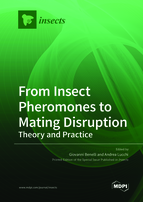From Insect Pheromones to Mating Disruption: Theory and Practice
A special issue of Insects (ISSN 2075-4450).
Deadline for manuscript submissions: closed (31 March 2021) | Viewed by 45579
Special Issue Editors
Interests: harmfulness and biological control of grapevine pests; pheromone mating disruption; implementation of "Area Wide Pest Management" strategies; insect vibrational communication, with particular reference to grapevine leafhoppers and planthoppers; morphology of insect pheromone glands and antennae
Special Issues, Collections and Topics in MDPI journals
Interests: insect behaviour; biological control; chemical ecology; mating disruption; ecotoxicology; integrate pest and vector management; One Health
Special Issues, Collections and Topics in MDPI journals
Special Issue Information
Dear Colleagues,
The study of insect chemical ecology with special reference to their pheromones is a fascinating field of research. Pheromone-mediated mating disruption (MD) represents an effective and eco-friendly biocontrol technique to manage insect pests of agricultural importance. Worldwide, agricultural pests on more than 800,000 hectares are estimated to be managed with MD. This technique relies on the release of synthetic sex pheromones from dispensers in crops, interfering with mate finding and reproduction of the pest through both competitive and non-competitive mechanisms. Unfortunately, the use of MD is still restricted to a rather limited number of crop pests, with special efforts being directed toward moths. However, the MD potential is huge and urgently needs to be explored further.
In this framework, the present Special Issue welcomes theoretical, laboratory, and field studies on insect pheromones, as well as on MD efficacy against insect species of economic importance, with special reference to the development of novel MD tools and approaches, their mechanisms of action, optimization of release geometries, cost-effectiveness, and possible non-target effects. Both original research and reviews will be considered for publication.
Best regards,
Prof. Dr. Giovanni Benelli
Prof. Andrea Lucchi
Guest Editors
Manuscript Submission Information
Manuscripts should be submitted online at www.mdpi.com by registering and logging in to this website. Once you are registered, click here to go to the submission form. Manuscripts can be submitted until the deadline. All submissions that pass pre-check are peer-reviewed. Accepted papers will be published continuously in the journal (as soon as accepted) and will be listed together on the special issue website. Research articles, review articles as well as short communications are invited. For planned papers, a title and short abstract (about 100 words) can be sent to the Editorial Office for announcement on this website.
Submitted manuscripts should not have been published previously, nor be under consideration for publication elsewhere (except conference proceedings papers). All manuscripts are thoroughly refereed through a single-blind peer-review process. A guide for authors and other relevant information for submission of manuscripts is available on the Instructions for Authors page. Insects is an international peer-reviewed open access monthly journal published by MDPI.
Please visit the Instructions for Authors page before submitting a manuscript. The Article Processing Charge (APC) for publication in this open access journal is 2600 CHF (Swiss Francs). Submitted papers should be well formatted and use good English. Authors may use MDPI's English editing service prior to publication or during author revisions.








